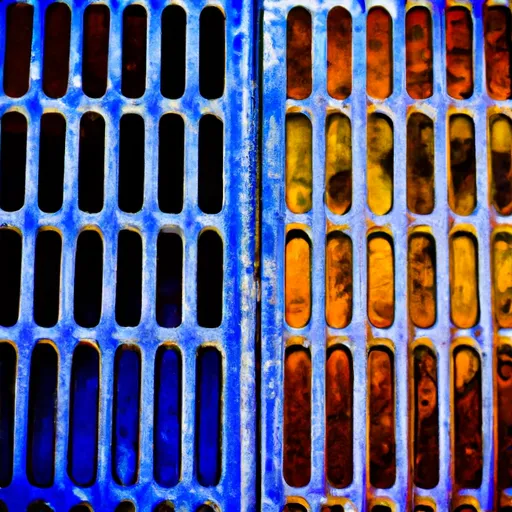
Have you ever found yourself staring down at a grate, feeling uncertain about which side is up? You’re not alone. It’s a common question that many people ask themselves when they encounter a grate, whether it’s on a stove, a grill, or a fireplace. But fear not, dear reader! We’re here to help you solve this mystery once and for all.
Picture this: you’re standing in front of your grill, preparing to cook up a storm. You’ve got your meat, your vegetables, your spices, and your tongs. But as you glance down at the grate, you suddenly realize that you’re not sure which side is up.
Is it the flat side? The angled side? Does it even matter? Don’t worry, we’ve got you covered. In this article, we’ll explore the different sides of the grate, the factors to consider when deciding which side to use, and even some tips for experimenting with both sides.
By the end of this article, you’ll be a grate expert and you’ll never have to worry about which side is up again.
The Flat Side of the Grate
You’ll want to make sure the surface that’s smooth and flat is facing upwards, so that your food can cook evenly and not get stuck to any rough edges. This flat side of the grate is usually found at the bottom of the grill, and it’s what your food will be cooking on.
The flat side is also easier to clean, so you won’t have to spend as much time scrubbing away at any food that gets stuck. If you’re not sure which side of the grate is flat, try running your hands over it. You should be able to feel the difference between the flat side and the rough side.
Additionally, if you have a grate with one side that’s flatter than the other, make sure that the flat side is facing upwards so that your food cooks evenly. By paying attention to which side of the grate is facing up, you’ll be able to cook your food to perfection every time.
The Angled Side of the Grate
The slanted surface of the metal bars is designed to optimize airflow and prevent debris buildup. This means that the angled side of the grate should always face upwards.
When the grate is placed in this way, air can flow freely through the grate, keeping your fire burning strong. If you’re not careful and place the grate with the angled side facing down, it could cause problems with airflow and even lead to your fire going out prematurely.
So, when you’re getting ready to build your fire, make sure to double-check which side of the grate is facing up. By doing so, you’ll ensure that your fire burns smoothly and efficiently. Plus, you’ll impress your friends and family with your fire-building skills!
Remember, the angled side of the grate is your friend, so show it some love and keep it facing upwards.
Factors to Consider
Before you start building your fire, take into account all the different factors that could affect its efficiency and longevity. One important factor is the position of the grate. While you may have already learned about the angled side of the grate, it’s also important to consider other elements that can impact your fire.
Here are some factors to keep in mind when deciding which side of the grate is up:
– Type of wood: Softer woods like pine burn faster and hotter, while denser hardwoods like oak burn slower and produce more heat. Consider which side of the grate will allow for the best airflow for your specific type of wood.
– Wind direction: If there’s a breeze blowing, you’ll want to position the grate so that the wind is blowing into the firebox. This will help to increase the oxygen flow and keep the fire burning hotter.
– Fire size: If you’re building a larger fire, you’ll want to position the grate with the angled side up for better airflow. For smaller fires, it may not matter as much.
– Type of fuel: If you’re using charcoal or briquettes, you’ll want to position the grate with the flat side up to provide a stable base for the fuel.
– Cooking method: If you’re using the fire for cooking, you’ll want to position the grate with the food side up to prevent any food from falling through the gaps.
By considering these factors, you can ensure that your fire burns efficiently and for as long as possible. Plus, you’ll feel like a true fire-building pro!
Experimenting with Both Sides
If you’re feeling adventurous, try flipping the grate over and experiment with the airflow to see if you can create a blazing inferno that could melt steel!
Sometimes, grates are not marked with an indication of which side should be up, so it’s worth a shot to try both sides. You might be surprised at the difference it can make.
By testing both sides of the grate, you can determine which side produces the best flame and heat output. This knowledge will come in handy the next time you light up your grill or fireplace. Plus, you’ll have the satisfaction of knowing you’ve uncovered a little secret about the workings of your grate.
So go ahead and give it a try – you might just discover something new!
Final Thoughts and Recommendations
You’ll want to hear my final thoughts and recommendations on getting the most out of your grill or fireplace.
After experimenting with both sides of the grate, I’ve come to the conclusion that it’s best to use the convex side facing up. This is because the convex side allows for better airflow, which helps to evenly distribute heat and prevent hot spots on the grill or in the fireplace.
Using the convex side facing up also helps to prevent food from sticking to the grate and makes it easier to clean.
So, if you want to get the most out of your grill or fireplace, make sure to use the convex side facing up. It may seem like a small detail, but it can make a big difference in the quality of your cooking or the efficiency of your fireplace.
Conclusion
So there you have it, you now know which side of the grate is up!
While the angled side is often recommended for better airflow and heat distribution, the flat side can also work just as well. It ultimately depends on your personal preference and the type of cooking you plan to do.
But wait, you may be thinking, “Does it really matter that much which side is up?” Well, while it may not be the most crucial detail in your cooking, paying attention to the orientation of your grate can make a difference in the taste and texture of your food.
Plus, taking the time to properly set up your grill can show your dedication and love for the art of cooking. So go ahead, try out both sides and see which one works best for you.
Happy grilling!



